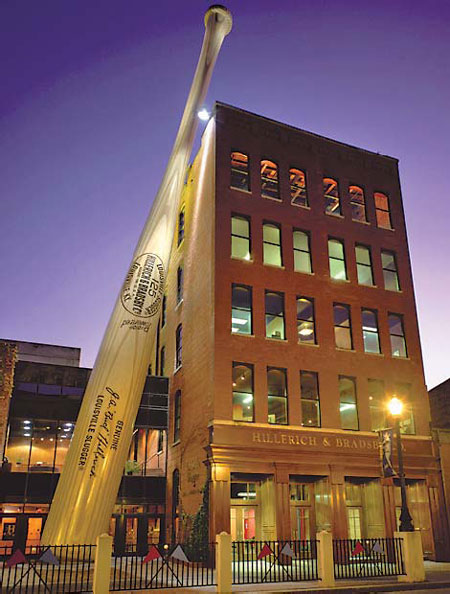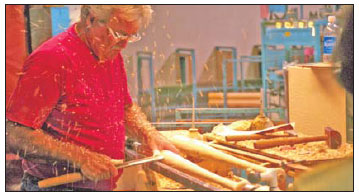Louisville Slugger

 |
|
A wood turner makes a new bat for a modern major-leaguer.[Photo/China Daily] |
It's all about hitting a baseball at this factory museum in Kentucky. Mike Peters gets into the swing of it.
The town baseball team's name, the Louisville Bats, is synonymous with the mighty wood that Babe Ruth and many others used to smack home runs into history. So why is the team mascot a fuzzy flying mammal?
Probably because a man in a Buddy Bat suit is cuter than a wooden stick - flopping around the sidelines leading cheers and entertaining kids during a game. And while the baseball team offers a pleasant afternoon on the riverfront - and $1 beers, an unheard of bargain at US professional sports events - the bats you really want to see in Louisville are not hairy but sleek.
Before or after the game, head for the Louisville Slugger museum, a monument to a company that made it to the top of its class not once but twice.
Hillerich & Bradsby Co. was once a leading producer of butter churns, as well as roller skids, bed posts, tenpins and wooden bowling balls. The demand for butter churns began to diminish after 1900, but a new game called baseball was catching on, and Bud Hillerich, son of founder J. Frederick Hillerich, began turning a few bats on the company's wooden lathes as a sideline.
Wooden bats had become a lynchpin of the business by 1905, when Honus "The Flying Dutchman" Wagner, a star for the Pittsburgh Pirates, signed a contract as the first player ever to endorse a bat. His autograph was also the first to be used on a bat and the first time a professional athlete endorsed an athletic product. After Wagner, a parade of stars made Hillerich & Bradsby's "Louisville Sluggers" their own: home-run king Ruth, Mickey Mantle, Harry "The Hat" Walker, Ted Williams and about 60 percent of today's players, including top hitters such as Derek Jeter and Kevin Youkilis.
The Louisville Slugger is the official bat of Major League Baseball.
Visitors to the plant can watch wood turners make bats for their favorite stars.
"Compared to the old-time greats like Ty Cobb, today's pros use more lightweight bats with thinner handles," our guide says. "Almost half of the players have the bats 'cup balanced', which means about three-quarters of an ounce of wood is scooped out of the end of the barrel, which also makes the bat lighter." He gets quiet as we watch a lathe scream into a block of white ash that will become a Model C271, the firm's most popular design, originally custom-made for Jose Cardenal, now a Cincinnati Reds coach.
"You can swing a lighter bat faster," he says, "so the ball goes further."
"Do you make all of the bats out of ash?" one tourist asks with a doubting frown. He's watching another craftsman wipe down a black bat with the routed signature of the Yankees' Alex Rodriguez gleaming from the "sweet spot". Most bats are northern white ash, our guide explains, "but about 40 percent are now made from maple at some players' request".
"That's model P72/C271C," he adds glibly, pointing at the A-Rod bat. "It's not ebony like at lot of people think. It's ash, with a black finish: 34 inches, 31 ounces. Exactly, every time.
That sort of precision helped make the Louisville Slugger a success story: amateur baseball players across the country could purchase the bat model of their favorite big-league player. In 1915 the Louisville Slugger first appeared in a youth-size model. A national ad campaign followed and by 1923 the company was producing 1 million bats a year.
Hillerich & Bradsby Co. celebrated the 125th anniversary of Louisville Slugger in 2009, and nearly 180,000 visitors come to the each year looking for history: Babe Ruth's bat, on which he carved a notch for every home run he hit with it; The Signature Wall, with more than 6,000 player autographs burned into the company's trademark white ash; the world's largest bat at the entrance.
Altogether, there are 14,000 square feet of exhibits and archives. And after all that inspiration, you can step into a batting cage and face down a 90-mile-an-hour fastball with any model of Louisville Slugger you think might make you a home-run king.














